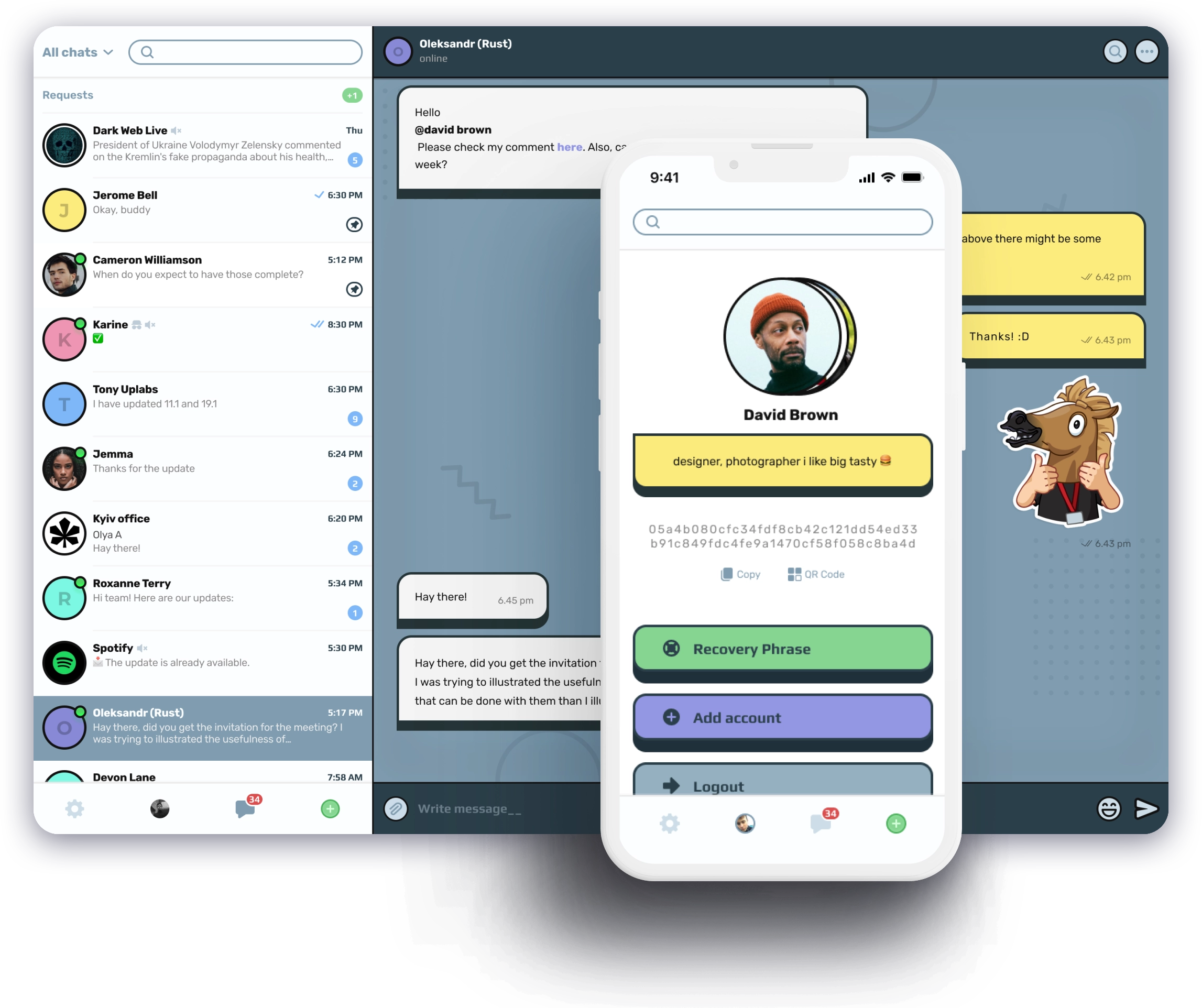Navigating mobile app development has become easier through the introduction of cross-platform mobile app development. By using a single codebase for both Android and iOS, developers can streamline the development process and ultimately deliver projects faster with fewer resources than traditional methods. This approach enables businesses to reach a broader audience more quickly and efficiently.
With the cross-platform app market projected to hit $546.7 billion by 2033, it’s clear this method is here to stay. Developers now have the option to write code once and deploy it across multiple platforms. This saves significant time and effort compared to developing separate native apps. This approach not only makes maintenance a breeze but also ensures a seamless user experience across all devices.
Not sure where to start? Here’s our list of cross-platform mobile development tools that can make your 2024 a success, equipping you with a “work smarter, not harder” mindset.
What Is Cross-Platform Mobile Development?
Cross-platform mobile development lets you build apps that work on multiple mobile operating systems (like iOS and Android) from a single codebase. This approach speeds up development, cuts costs, and simplifies maintenance, setting it apart from native and hybrid methods.
The Landscape: Native, Hybrid, and Cross-Platform
To appreciate the benefits of cross-platform development, it’s important to compare it with other development approaches — namely, native and hybrid.
Native apps are written separately for each mobile platform. iOS apps use Swift or Objective-C, while Android apps rely on Kotlin or Java. Although native apps perform well and can use platform-specific features, they require more time and money to develop.
Hybrid apps are web apps wrapped in a native shell, built using web technologies like HTML, CSS, and JavaScript. While faster to develop, they usually don’t perform as well as native apps.
Cross-platform tools let you write the app’s core logic once, then compile it into native code for multiple platforms. This balanced approach offers a good trade-off between performance, speed, and cost.
Why You Should Choose Cross-Platform Development
With users becoming even more mobile-centric, businesses must have a strong app presence across various platforms. Cross-platform development offers a compelling solution that can significantly benefit your organization. Adopting this approach brings several benefits, such as:
- Budgetary Savings, Boosted ROI. Cross-platform development is your wallet’s best friend. One technology and one set of graphics means fewer working hours with lower project costs. You’re also cutting down the spend on testing, deployment, and support. Greater efficiency produces higher returns.
- Faster Turnaround. Why wait, when you could make one app for all platforms? Cross-platform means you get to market faster. The sooner your app’s out there, the sooner you start seeing benefits. Time is money, after all.
- Consistent Logic, Fewer Headaches. Apply the same codebase for identical logic across all platforms. No double or triple work here. You get fewer errors, and changes are a breeze. Your app works smoothly everywhere.
- Uniform Look, Seamless Experience. Consistency is key. With cross-platform development, your app looks and feels the same, no matter the device. One team, one code—one seamless user experience.
- Wider Reach, Bigger Impact. Why limit yourself? Cross-platform apps hit all devices and all users. More reach, more impact—without breaking the bank.
Top-7 Cross-Platform Mobile Development Tools in 2024
As mobile application development evolves, the tools available to developers will also see significant improvements. Among these, some stand out as the best cross-platform mobile development tools, offering a blend of efficiency, reusability, and versatility. Let’s dive into our curated list for 2024, starting with a platform that has gained widespread recognition.
Among other popular mobile app frameworks, Flutter stands out as a tool that enables the creation of natively compiled applications across multiple platforms using a single codebase. This makes Flutter a powerful choice for multi-platform app development, offering developers the ability to maintain a consistent user experience across iOS, Android, and more.
What sets Flutter apart is its use of Dart programming language, which is designed to optimize both the development and performance of apps. The framework boasts an extensive library of pre-designed widgets and UI elements, which makes it easier to build visually appealing apps.
Flutter also supports asynchronous programming.
- Flutter’s direct compilation to native code ensures excellent performance comparable to native apps
- A broad range of customizable widgets and UI elements makes it easy to create a unique user experience
- The single codebase approach streamlines development and reduces time to market
- Being a Google product, Flutter enjoys a large, active community and extensive documentation
- Dart is not as popular as JavaScript, and some developers may find it challenging to pick up
- Although growing, Flutter’s ecosystem is not as extensive as native or some other cross-platform solutions
- Apps built with Flutter can be larger and consume more memory compared to native apps
React Native, created by Facebook, is a powerhouse framework that lets you build mobile apps using JavaScript and React. It’s a top pick for developers well-versed in JavaScript due to its seamless integration with native modules and components.
React Native has powered apps for major players like Airbnb, which initially chose it for its promise of code reuse and rapid development. Despite Airbnb’s eventual move away from React Native due to technical and organizational challenges, their journey highlights both the potential and pitfalls of this tool. They found that while React Native accelerated development and allowed for shared code across platforms, it also introduced complexities such as bridging infrastructure and asynchronous rendering issues. These insights underscore the importance of evaluating React Native within the context of your specific project requirements and team capabilities.
- Leveraging JavaScript makes it easy for web developers to transition to mobile app development
- Being around for a while, React Native has a large community, extensive libraries, and third-party plugins
- Like Flutter, React Native also allows for high levels of code reusability, accelerating development timelines
- Developed and maintained by Facebook, React Native benefits from regular updates and a strong community
- While generally good, performance can suffer when dealing with complex animations or high computational tasks
- Some native functionalities may require custom modules, adding complexity and potential performance bottlenecks
- The community contributes various modules and packages, but quality can vary, requiring careful selection
NET MAUI (Multi-platform App UI) is Microsoft’s successor to Xamarin. It allows developers to build native applications for Android, iOS, macOS, and Windows using a single codebase written in C#. As the future of cross-platform development under Microsoft’s umbrella, .NET MAUI leverages the .NET framework to deliver high-performance apps with a unified experience across multiple platforms.
- .NET MAUI provides a single project structure for all platforms, simplifying the development process and reducing complexity
- Built on the .NET framework, .NET MAUI ensures high performance and efficient resource utilization
- Backed by Microsoft, .NET MAUI benefits from a robust and regularly updated ecosystem, comprehensive documentation, and community support
- With .NET MAUI, developers can share a significant portion of their code across platforms, speeding up development and reducing maintenance efforts
- The seamless integration with Visual Studio offers powerful debugging, profiling, and productivity tools to enhance the development workflow
- For developers familiar with the former framework, transitioning from Xamarin to .NET MAUI may require some learning
- While .NET MAUI promotes code sharing, certain platform-specific customizations may still be necessary, potentially complicating the development process
- Similar to Xamarin, applications built with .NET MAUI can have larger file sizes, which can impact download times and memory usage
Kotlin Multiplatform is an experimental feature in Kotlin that allows you to run your code on different platforms including JVM, Android, iOS, JavaScript, and native. Developed by JetBrains, this tool aims to eliminate the “write once, run everywhere” dilemma by allowing you to share common code across different platforms, while also letting you write platform-specific code where necessary.
- Uses Kotlin, which is already popular among Android developers, making it easier for teams to adapt
- Allows you to share common logic across platforms, reducing both development time and potential for errors
- Enables the use of native libraries and APIs, ensuring optimal performance
- JetBrains’ strong backing and regular updates provide a robust ecosystem
- Still in an experimental phase, which may deter some enterprises from adopting it
- Limited community support and third-party libraries as compared to more established solutions
- The need to write some platform-specific code can offset the advantages of a single codebase
Ionic is an open-source SDK for hybrid mobile app development. Built on top of AngularJS and Apache Cordova, it enables developers to use web technologies like HTML, CSS, and JavaScript to build multi-platform apps. Ionic’s main appeal lies in its ease of use and the speed at which apps can be developed and deployed.
- Web technology stack makes it accessible for developers familiar with HTML, CSS, and JavaScript
- A rich set of UI components accelerates the development of visually appealing apps
- Built on popular frameworks like Angular and React, allowing for an easier learning curve
- Strong community support and extensive documentation simplify the development process
- Performance can lag behind native apps, especially in graphics-heavy applications
- Reliance on plugins for native functionalities may add complexity
- Limited in terms of accessing native device features compared to fully native solutions
Unity is predominantly a game development engine, but its capabilities extend to creating cross-platform mobile applications as well. As one of the notable mobile app cross-platform development tools, Unity offers a rich graphical interface along with drag-and-drop functionality. The engine is written in C#, making it accessible for developers familiar with statically typed languages.
- Highly versatile, capable of creating both 2D and 3D applications, beyond just games
- Supports an extensive range of platforms, from mobile and desktop to AR/VR devices
- Strong community and a plethora of online resources make it easier to troubleshoot issues
- Integration with various ad and analytics services provides comprehensive app monetization and tracking solutions
- Might be an overkill for simple, text-based applications or apps with limited UI complexity
- Could be expensive, with licensing fees that may not be affordable for smaller projects
- Some mobile-specific features might require additional plugins or custom scripting
NativeScript is an open-source framework that enables developers to use web technologies like Angular, Vue.js, or plain JavaScript to build native mobile apps. With NativeScript, you can create a single codebase that runs on both iOS and Android platforms, leveraging native components for optimal performance. As one of the best free cross-platform mobile app development tools, NativeScript offers a cost-effective solution for building high-quality native apps.
- Compatible with popular front-end frameworks like Angular and Vue.js, making it easier for developers to get started.
- NativeScript directly utilizes native APIs and components, offering performance that is very close to native apps.
- The framework has a rich set of plugins, allowing you to extend your app’s functionalities easily.
- Being around for several years, NativeScript has developed a robust community that actively contributes to its ecosystem.
- For those not already familiar with Angular or Vue.js, there might be a steeper learning curve compared to other tools for cross-platform mobile development solutions
- Debugging can be complex, as you’re essentially handling both Android and iOS platforms
- Applications may result in larger package sizes compared to native solutions
Factors to Consider When Choosing a Cross-Platform Tool
Mobile App SDKs
Mobile App SDKs: Look for a robust SDK offering out-of-the-box features like UI elements, data handling, and connectivity to speed up development.
Popular Frameworks: Opt for popular frameworks like React Native or Flutter, which are suitable options for both iOS and Android application development. They have strong community support, frequent updates, and extensive third-party libraries. Align with your project needs and skills.
Development Environment: Choose a tool that integrates seamlessly with your existing infrastructure, whether cloud-based or local, to ensure a smooth development process.
Beyond these fundamental aspects, there are additional important criteria that can help you make a well-informed decision. Here’s what to keep an eye on:
Flutter
Dart
Excellent
High
Android, iOS, Web
Moderate
Google Ads, Alibaba
React Native
JavaScript
Excellent
Very High
Android, iOS, Web
Easy
Facebook, Instagram
NET MAUI
C#
Excellent
High
Android, iOS, macOS, Windows
Moderate
SportsEngine
Kotlin Multiplatform
Kotlin
Good
Growing
iOS, Android, JVM, Native
Moderate
JetBrains Space, Cash App
Ionic
JavaScript
Moderate
High
Android, iOS, Web
Easy
Sworkit, Untappd, JustWatch, MarketWatch
Unity
JavaScript, C#
Good
High
Multiplatform
Moderate
Pokémon GO, Monument Valley
NativeScript
JavaScript, Angular, Vue
Very Good
Moderate
Android, iOS
Moderate to Hard
Strudel, Dwitch
Our Top Choice for Your Next Project: Flutter
After a thorough comparison of the top three cross-platform mobile development tools, one tool clearly stands out as our top recommendation. As a company with over 18 years of experience in mobile app development, we at Redwerk have seen firsthand the transformative potential of this tool. Its direct-to-native compilation ensures excellent performance, rivaling that of native apps. The extensive library of customizable widgets and UI elements allows for the creation of visually appealing and highly functional apps.
Furthermore, this tool’s single codebase approach streamlines development, reducing time-to-market and maintenance costs. Backed by a tech giant, it boasts a robust and active community, providing developers with extensive support and resources. For businesses looking to develop high-quality cross-platform applications efficiently, this tool is the optimal choice.
Conclusion: The Future Is Cross-Platform
The growing popularity and technological advancements of cross-platform tools signal a clear shift in the mobile app development landscape. With tech giants like Facebook and Google investing heavily in cross-platform frameworks, it’s evident that this approach isn’t just a trend — it’s the future.
At Redwerk, we’ve been in the game for over 18 years, providing top-notch mobile app development services, from native to cross-platform and web app solutions. While we excel in native technologies, our experience indicates that the future lies in cross-platform development.
If you’re considering partnering with a development company, make sure to choose one that understands the future of the mobile landscape. You can find a list of top mobile app development companies in our blog to guide you in making an informed choice.
Whether you’re considering iOS Application Development or Android Application Development, our vast experience and expertise can help guide your project to success. Let us bring your mobile app idea to life in the most efficient, cutting-edge way possible.
Discover how we built Tingl, a secure blockchain messenger, using Flutter for unparalleled security and complete anonymity





